How to Identify Esports Potential: Key Indicators and Strategies
Updated On: November 12, 2025 by Aaron Connolly
Understanding Esports Potential
Spotting esports potential means looking for specific skills, mental traits, and dedication that set future competitors apart from casual players.
If you can identify these early, you’ll know exactly where to focus your training. Plus, understanding common myths saves time and energy.
Defining Esports Potential
Esports potential is a mix of mechanical skill, smart strategy, and the right competitive mindset.
You’ll see this in reaction times, game sense, and how well someone adapts under pressure.
Core mechanical skills are things like sharp aim, quick decisions, and being able to pull off moves over and over. The best players usually have reaction times under 200 milliseconds and keep their accuracy above 60% in shooting games.
Strategic awareness is about understanding team dynamics, controlling the map, and predicting what opponents will do next. Players with real potential read the game quickly and talk things out with their teammates.
Mental resilience is what separates good players from the truly great. You’ll notice it when someone stays cool during big moments, learns from their losses, and keeps focus during long practice sessions.
| Skill Type | Beginner Level | Competitive Level | Pro Level |
|---|---|---|---|
| Reaction Time | 250-300ms | 180-220ms | 150-180ms |
| Training Hours/Week | 5-10 | 20-40 | 50+ |
| Game Knowledge | Basic mechanics | Advanced strategies | Meta mastery |
Heads up: Raw talent is just the start. The real difference comes from dedication and smart training.
Importance of Early Identification
If you spot potential early on, you can skip years of aimless practice.
Most pros start serious training between 14 and 18, which gives them a head start.
Career planning is easier when you know your own strengths. You can pick the right games, find teams that fit, and set goals that actually make sense.
When you have direction, training gets way more efficient. Players improve much faster when they know what they’re aiming for.
Resource allocation becomes less of a guessing game. If you know your potential, you’ll know if it’s worth investing in coaching, gear, or joining a team.
Most esports careers peak between 18 and 25. If you start focused training by 16, you’ll give yourself the best shot at going competitive.
Quick tip: Record yourself playing for half an hour. Afterwards, watch the footage and see where your decisions and mechanics stand.
Common Misconceptions
A lot of people think esports potential is just about being addicted to games or born with insane reflexes. That’s not really true.
“More hours always equals better results” isn’t right. Practicing with purpose beats endless grinding every time. Pros spend their time on deliberate practice, not just racking up hours.
“You need expensive gear right away” is another myth. Basic equipment is fine for figuring out your potential. At first, your skills matter way more than your hardware.
“Age limits are strict” isn’t quite true either. Reflexes might peak early, but games that are more strategic or involve management can suit older players.
“Solo skill trumps teamwork” misses the big picture. Most esports rely on coordination. You rarely see solo stars win without a good team behind them.
Potential doesn’t show up overnight. It usually takes 6-12 months of focused practice before you really see results.
Try this: Pick one skill to track for a month—maybe aim accuracy or how you make in-game decisions.
Core Performance Metrics in Esports
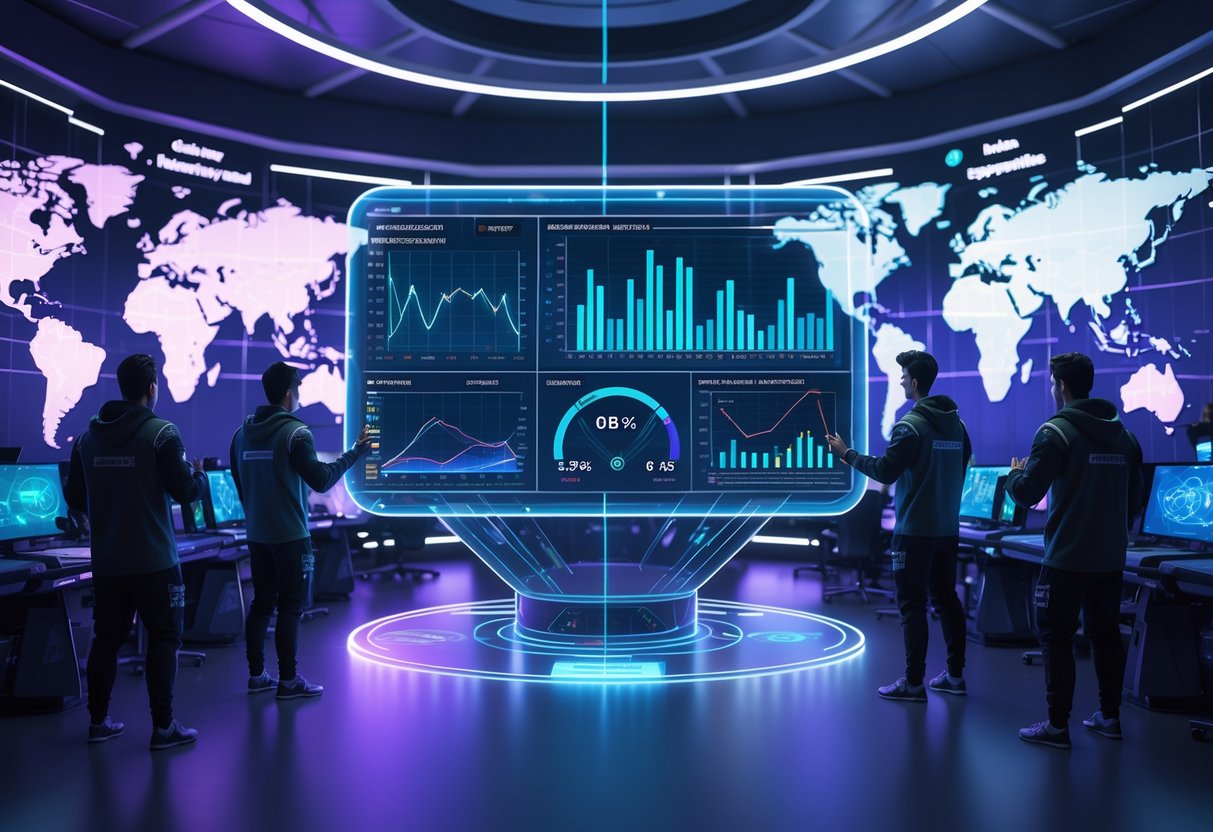
If you want to identify esports talent, you need to measure the skills that separate amateurs from pros.
We look at mechanical precision, smart decision-making, and the ability to perform when it matters most.
Mechanical Skill Assessment
Mechanical skills are the backbone of competitive play. You’ll see this in reaction time, accuracy, and how precise someone is with their inputs.
Key Mechanical Metrics:
- Reaction Time: Pros average 150-200ms in FPS games
- Actions Per Minute (APM): Top RTS players hit 300-400 APM
- Accuracy Percentage: Elite CS players have 25-30% headshot ratios
- Input Consistency: Frame-perfect moves in fighting games
You can measure these skills using aim trainers like Kovaak’s or by checking in-game stats.
Mechanical ability usually peaks in the late teens or early twenties.
Most esports organizations actually run standard tests for this stuff. Players go through reaction time challenges and accuracy drills. The results set a baseline for performance metrics.
Just a note: High mechanical skill isn’t everything. Some players with great mechanics still struggle with teamwork.
Pro teams track improvement over time. They care more about steady gains than one lucky performance.
Evaluating Game Sense
Game sense is about making smart decisions in the middle of a match. That covers map awareness, timing, and reading your opponents.
Critical Game Sense Indicators:
- Positioning: Picking the best spots during fights
- Resource Management: Making smart economy choices in shooters
- Timing: Knowing when to fight or fall back
- Adaptation: Changing strategies on the fly
Game sense usually develops with experience. Coaches and scouts watch demo reviews and break down the player’s decisions.
Top players show their game sense by making the right choices over and over. They avoid bad positions and time their moves perfectly.
A lot of retired pros become great coaches. Even when their mechanics fade, their strategic thinking often gets better.
Scouts pay close attention to how a player fits into a team. They want someone who lifts up teammates with smart calls and good positioning.
Consistency in High-Pressure Situations
Champions don’t just play well—they stay reliable when the pressure’s on.
We look at how their performance changes in big moments, like tournament finals or do-or-die matches.
Pressure Performance Metrics:
- Clutch Success Rate: Winning 1v2 or 1v3 situations
- Tournament Performance: Comparing stats from regular games to playoffs
- Comeback Ability: How they play when they’re behind
- Mental Resilience: Bouncing back after mistakes
Pro teams watch footage from high-stakes games. They see if a player’s performance holds up under stress.
Some players look great in practice, but freeze up live. Others seem to thrive when the pressure’s highest. That’s where you see real mental strength.
Quick tip: Watch how players react right after a big mistake. The best ones refocus quickly instead of getting stuck on errors.
Individual stats only tell part of the story. The best prospects have strong fundamentals and deliver when it counts.
Data Analytics for Talent Identification
Modern esports scouting leans hard on data. Teams track thousands of gameplay stats to find talent that old-school scouting might miss.
Analysing In-Game Statistics
Teams gather tons of data during matches—reaction times, accuracy, decision speed, movement patterns, you name it.
Scouts pay attention to:
- Kill-to-death ratios over long stretches
- Clutch performance under pressure
- Efficiency with resources
- Team coordination scores
Big orgs like Cloud9 use algorithms to crunch these numbers. They spot players who stay consistent in all sorts of situations.
Sometimes, the data reveals things you’d never notice by eye. A player might have average kills but perfect positioning that wins games.
But don’t forget: Stats alone aren’t enough—context matters.
Using Predictive Analytics
Teams use advanced analytics to predict which players will get better over time.
They run machine learning models on gameplay from amateur leagues, searching for the same traits today’s pros showed early on.
These models look at:
- How quickly someone improves
- How fast they adapt to new strategies
- Consistency over several months
- How well they take coaching
Teams like T1 and Gen.G keep huge databases on player growth. This lets them spot up-and-comers in lower leagues who have the right patterns.
The tech can even estimate a player’s potential ceiling. That way, teams spend resources on players with real long-term promise.
Benchmarking Against Elites
Analytics let teams compare amateurs directly to pros. They build detailed profiles of their top players.
The benchmarking process:
- Map out elite player stats across key metrics
- See which numbers actually lead to success
- Compare prospects to these benchmarks
- Find players who stand out in the most important areas
| Metric Type | Elite Benchmark | Minimum Threshold |
|---|---|---|
| Reaction Time | <150ms | <200ms |
| Accuracy Rate | >75% | >60% |
| Decision Speed | <2 seconds | <3 seconds |
This approach uncovers players who might not look amazing overall, but shine in critical skills.
Some prospects have world-class mechanics but need to work on tactics.
Teams also track how fast players improve. Quick learners often have more potential than those with better stats but slower growth.
Speed and Reaction Assessment
Quick reflexes and smart decisions make the difference between a good and a great esports player.
You need to test both how fast someone reacts and how quickly they make the right call under pressure.
Measuring Reaction Time
Pro esports players usually have reaction times between 100-250ms to visual cues. That’s 30-40% better than the average gamer.
You can check reaction time with tools like Human Benchmark, or go high-tech with eye-tracking gear to see exactly when players spot threats.
Your brain works in three steps:
- Receives the signal (10ms or so)
- Processes and decides (70-150ms)
- Sends commands to muscles (20-40ms)
Elite players shine in the middle step. They process complex game situations way faster than most.
Test reactions during actual gameplay for the best results. Simple color-change tests can only tell you so much. Each game genre demands its own reaction patterns.
Key things to measure:
- Simple reaction time (one stimulus)
- Choice reaction time (multiple options)
- Recognition speed (spotting threats)
Analysing Decision-Making Speed
Speed’s useless without accuracy. You want to see how fast players make the right choice when options pile up.
Esports coaches look for these decision-making skills:
- Switching attention between tasks
- Spotting patterns in enemy moves
- Timing when to use abilities
Testing uses scenarios that get harder and harder. Players face situations where they have to act fast and smart. Coaches track both speed and quality.
Common assessment tools:
- Change Detection Tests (for spotting differences)
- Timewall Tests (for timing)
- Flanker Tests (for ignoring distractions)
Good players stay quick and accurate even when the pressure’s on.
Watch for players who get faster with practice. Natural talent helps, but being able to train decision speed is often more valuable for long-term growth.
Evaluating Individual Player Performance
Checking how individual players perform gives you the clearest clues about who might make it in competitive gaming.
Look at both their current skills and how quickly they pick up new things.
Strengths and Weaknesses Analysis
Performance metrics really show what a player can do. You want to check the numbers that actually matter for each game.
If you’re looking at first-person shooters, it’s all about these stats: • Kill/death ratio (K/D) • Accuracy percentage • Headshot percentage • Damage per round
For MOBAs like League of Legends, you’ll want to track: • CS (creep score) per minute • Vision score • Objective participation • Deaths per game
Just a heads up: Don’t get stuck on a single stat. Someone might have insane aim but always gets caught out of position.
The best way to spot talent development is by watching for consistency. See if a player keeps up solid performances across several matches, not just one lucky game.
Look for people who shine in specific areas. Maybe they’re team fight monsters but can’t win a 1v1. Someone else could be a tactical mastermind but fumble basic mechanics.
Quick win: Try tracking apps like Tracker.gg or Leetify. They’ll give you performance data so you don’t have to crunch numbers yourself.
Adaptability and Learning Curve
Pay attention to how quickly players adapt to new situations. That’s usually more important than just raw skill for long-term growth.
You can test adaptability by watching how players deal with: • New game updates or patches • Different team compositions • Weird strategies from the enemy • Playing roles they don’t usually play
Players who learn from mistakes improve the fastest. Good prospects will break down losses and change up their approach the next time.
See if they’re asking questions during practice. Players with real potential want to know why something works, not just what to do.
Check their match history over a few months—maybe 3 to 6. You’re looking for steady progress in key areas. If you see a big jump, they probably found a coach or started grinding seriously.
Players who adapt well usually try new strategies on their own. They’ll experiment in casual games and bring what works into the big matches.
You’ll find that players with strong learning curves watch pro gameplay and steal the best moves. They’re just naturally curious about the game, not just playing it for fun.
Team Synergy and Communication Skills
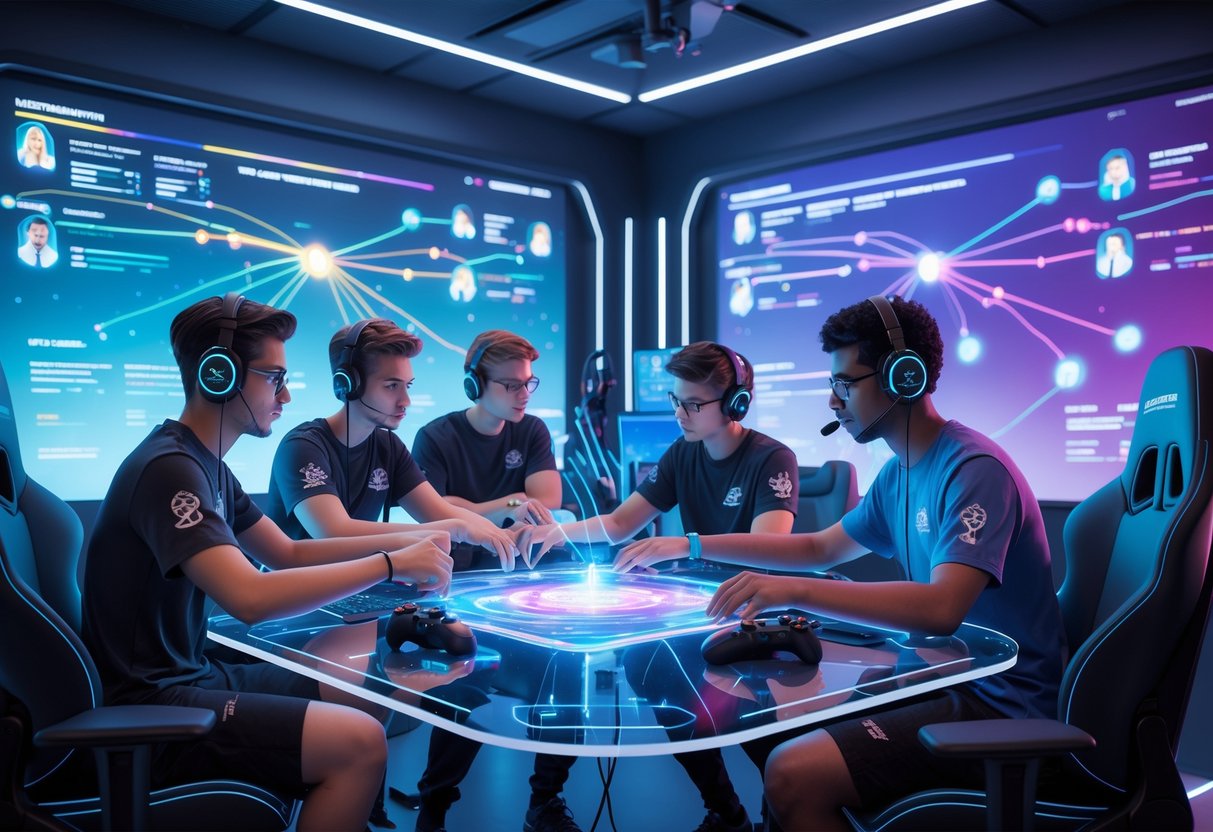
Strong team synergy lets a group of talented individuals play like a real team. Clear communication is what actually makes them click during tense matches.
You’ll see these qualities in teams that have compatible role assignments, solid feedback systems, and smooth in-game callouts.
Synergy Evaluation Methods
You can measure team synergy with a few practical methods that show how well players mesh together.
Match replay analysis really tells you the most. Watch how the team positions during fights. When players cover each other’s weaknesses without even talking, that’s real synergy.
Decision-making speed is another giveaway. Teams with good synergy pull off coordinated plays faster because they’re already anticipating each other’s moves. Try timing how long it takes them to set up a complicated strategy.
Role flexibility shows deeper chemistry. Players who switch up their playstyle to support teammates have strong team chemistry. You’ll notice this especially in scrims when they adjust positioning or item builds for the team.
Set up structured observation sessions during practice games. Use checklists to track:
- How fast players respond to callouts
- Positioning during objectives
- How quickly they adapt when the plan changes
- Who steps up to support struggling teammates
Performance consistency in different match situations reveals if the synergy is real. Teams that keep their coordination during comebacks or against tough opponents have genuine chemistry, not just surface-level teamwork.
Effective In-Game Communication
Clear communication protocols are what separate winning teams from a bunch of good players.
Callout systems need to be standard for everyone. Every player should use the same words for map spots, enemy locations, and tactics. If people mix up terms, confusion hits at the worst moments.
Information hierarchy matters a lot. Decide who calls the big plays and who just gives routine updates. Shot-callers handle macro stuff; the rest focus on the immediate fight.
Try running communication drills in practice. Set up situations where players have to relay info quickly. It helps build those automatic responses for real matches.
Voice discipline doesn’t come naturally. Players tend to repeat themselves or ramble when things get tense. Give feedback on clarity and cut the unnecessary chatter.
Timing protocols are underrated. Make rules about when to speak up (like spotting an enemy or calling cooldowns) and when to just focus.
Emotional regulation through communication keeps the team on track. Set up ways to give feedback that don’t kill morale, even if things go sideways mid-game.
Role Compatibility
Matching roles well lets players do what they’re best at while covering any team gaps.
Playstyle mapping helps you find who fits together naturally. Aggressive supports usually sync with careful ADCs, and decisive shot-callers mesh with adaptable teammates.
Communication preferences play a part. Some players love constant chatter, which makes them great in support or jungle. Others like to focus, which fits carry roles better.
Try trial rotations in practice. Mix up roles and see what clicks—you might stumble onto a combo you didn’t expect.
Personality assessment is useful too. Patient players handle late-game roles well, while people who make quick decisions do better early on.
Skill complementarity can make a team stronger than just stacking raw talent. Someone with average mechanics but great game sense can unlock a star teammate.
Backup role preparation is a must for tournaments. Every player should have a secondary role ready in case you need to shake things up or cover for someone.
Strategic Advantages and Gameplay Analysis

Strategic thinking is what really sets future champions apart. Players who handle complex strategies under pressure, adjust to opponent tactics, and keep up with game changes always have the edge.
Strategy Execution Assessment
We look for players who actually turn strategic concepts into wins, not just talk about them. That means watching how they coordinate team fights in League or pull off site takes in Valorant.
Strong strategic execution shows up in timing. Players who know exactly when to engage, retreat, or commit resources have next-level game sense. They don’t just know what to do—they know when to do it.
Key execution indicators:
- Consistent warding and map control
- Smart resource use during matches
- Coordinated ability usage in fights
- Clear comms when the pressure’s on
Top players bounce back from failed strategies fast. They’ll switch things up mid-game instead of stubbornly sticking to the plan. That flexibility often decides who wins.
Watch for players who can switch between aggressive and defensive play without missing a beat. That kind of adaptability shows they really get the flow of the game.
Opponent Analysis Techniques
Top players study their opponents relentlessly. They watch replays, track habits, and look for patterns to exploit.
Effective opponent analysis breaks down a few key things. Players check champion picks, item builds, positioning, and how opponents make decisions when the heat is on.
| Analysis Focus | What to Track | Why It Matters |
|---|---|---|
| Champion Pool | Preferred picks, ban targets | Reveals comfort zones and weaknesses |
| Early Game | Jungle paths, lane priorities | Predicts opening strategies |
| Late Game | Team fight positioning | Shows decision-making under pressure |
Advanced players build detailed opponent profiles before big matches. They’ll track things like average ward spots, rotation timings, and common mistakes.
The best analysis happens in the middle of games too. Players who can read what the enemy wants to do and adjust their own plan on the fly have insane strategic awareness.
Adaptability to Meta Changes
Game developers keep shaking up the meta, so players have to adapt constantly. The ones who roll with the changes, not against them, usually go the furthest.
Meta adaptation means more than just picking up new champions. You have to get why the changes matter and how they shift the whole game.
Signs of strong adaptability:
- Learning new champions fast
- Coming up with fresh strategies instead of just copying
- Keeping a positive attitude about updates
- Willingness to drop comfort picks
The fastest adapters often set the new meta. They’ll try weird stuff and find strong combos before anyone else.
Some promising players stall out because they can’t keep up with big updates. Others use those same changes to leap ahead. That mindset difference predicts who sticks around at the top.
Players who treat meta changes like fun puzzles—rather than annoying obstacles—have the mental flexibility needed for a pro career.
Talent Development Pathways
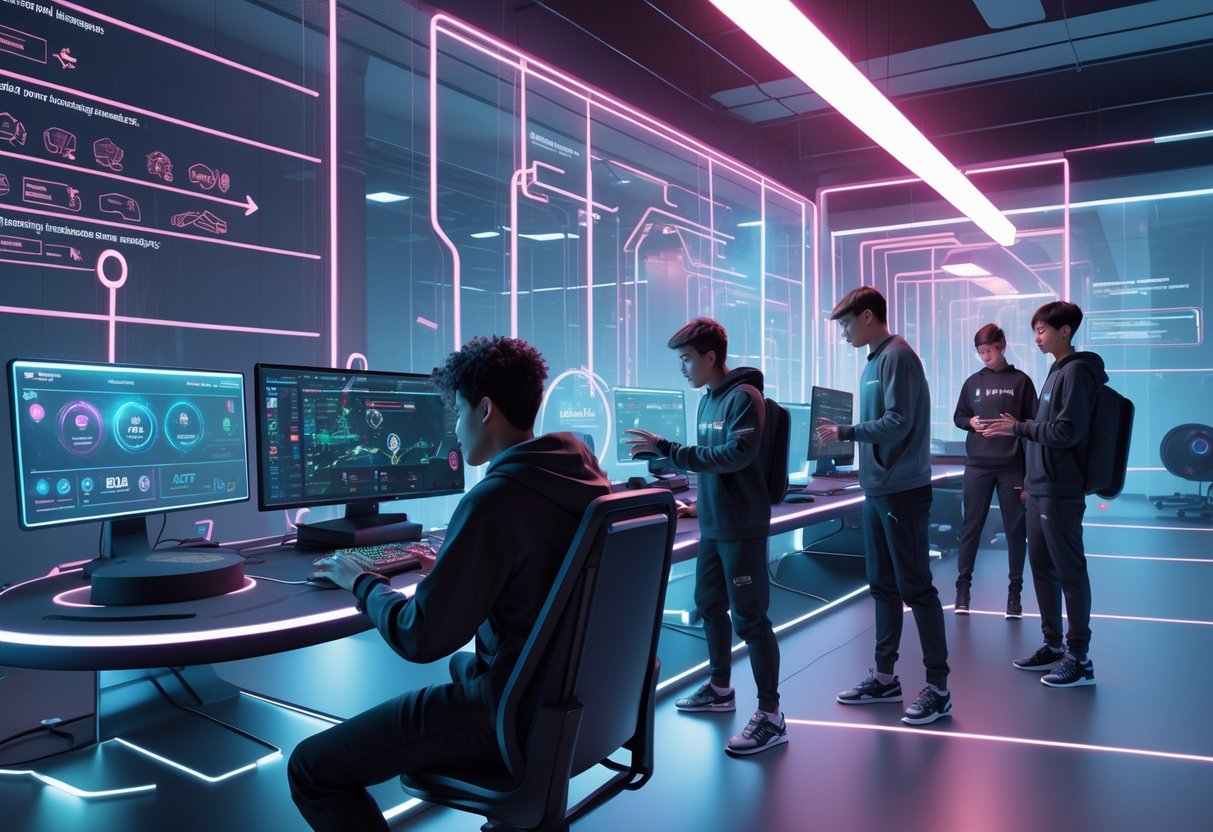
Building esports talent takes structured approaches that turn potential into real skill. The best development systems spot growth indicators early and lay out clear steps forward.
Identifying Growth Potential
Growth potential in esports isn’t just about current skill. Look for players who adapt fast and bounce back from mistakes without losing steam.
Coachability is the big one. Players who ask questions, take feedback, and actually change their habits usually outperform those who start out strong but won’t listen.
Mental resilience makes a huge difference. See how players react to losing streaks or high-pressure moments. If they keep their head and don’t tilt, you’re looking at someone with real promise.
Key things to watch for:
- Consistent improvement over a few months
- Strategic thinking beyond just mechanics
- Communication in team scenarios
- Time management for practice and matches
Don’t get fooled: Scouts often obsess over rank or stats. Raw talent without work ethic almost never turns into pro-level success.
Structured Skill Progression
Good talent development uses step-by-step training that builds skills over time. Most strong programs follow similar paths.
Foundation Phase (Months 1-6) is all about mechanics and basic game knowledge. Players spend about 60% of their time on solo skills, 40% on team stuff.
Development Phase (Months 6-18) shifts to tactics and role specialisation. Training moves to 40% individual and 60% team-based work.
Competition Phase (18+ months) puts players into regular tournaments and structured environments.
| Training Component | Foundation | Development | Competition |
|---|---|---|---|
| Individual Skills | 60% | 40% | 20% |
| Team Practice | 30% | 50% | 60% |
| VOD Review | 10% | 10% | 20% |
Quick win: Set up weekly performance reviews that track specific stats, not just general improvement. It keeps everyone accountable and shows progress clearly.
Role of Coaches and Analysts
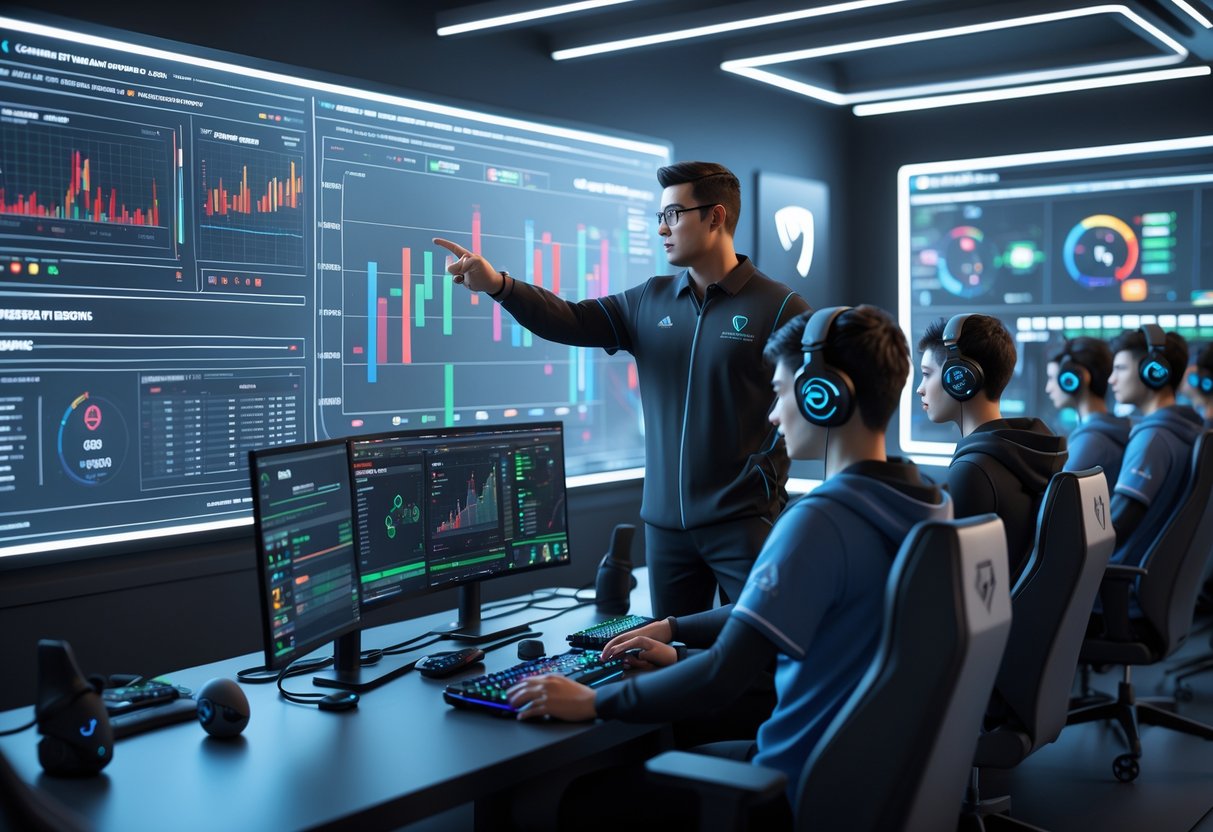
Coaches shape player skills with structured training, while analysts dig into data to spot team weaknesses and sharpen strategies. Both roles are absolutely vital for turning raw talent into championship-level performance.
Coaching Impact on Player Growth
Coaches work on each player’s mechanics and mental game with targeted routines. They’ll set up daily schedules that target specific weak spots—maybe it’s reaction time in Counter-Strike or nailing combos in Street Fighter.
Mental performance becomes a huge deal at higher levels. Coaches teach players how to handle tournament nerves and keep focus during wild matches. Many even bring in sports psychologists for breathing drills and pre-game routines.
Communication skills get a lot of attention too. Coaches show players how to make clear callouts and actually work together as a team. They’ll record scrims and review where comms fell apart.
Individual skill development means one-on-one sessions where coaches and players break down game footage together. They’ll call out things like bad positioning or predictable moves. That kind of detailed feedback speeds up progress way more than solo grinding.
Coaches also keep an eye on burnout. They balance tough training with rest, making sure players peak at the right time instead of burning out before the big events.
Analyst Contributions to Team Success
Analysts turn raw gameplay footage into real, usable insights with data analytics tools. They watch how opponents move, what weapons they grab, and the strategies they lean on across different matches.
This work builds up detailed opponent profiles that coaches and players can actually use.
They use performance metrics to spot issues inside the team too. Analysts track stats like accuracy, positioning, and quick thinking. They bring these numbers to team meetings and explain what matters most.
Before matches, analysts put together strategy guides based on what they’ve seen from rivals. They come up with several tactical plans, just in case the main one goes sideways. Heat maps often help show where the other team dominates—or falls apart.
During matches, analysts deliver real-time advice. They talk with coaches about the other team’s adjustments and offer new counter-strategies between rounds. Sometimes, this live feedback flips the result of a match.
Afterward, analysts break down big plays. They make video clips of both the highlights and the mistakes, so everyone learns something from each game.
Designing Effective Training Programmes
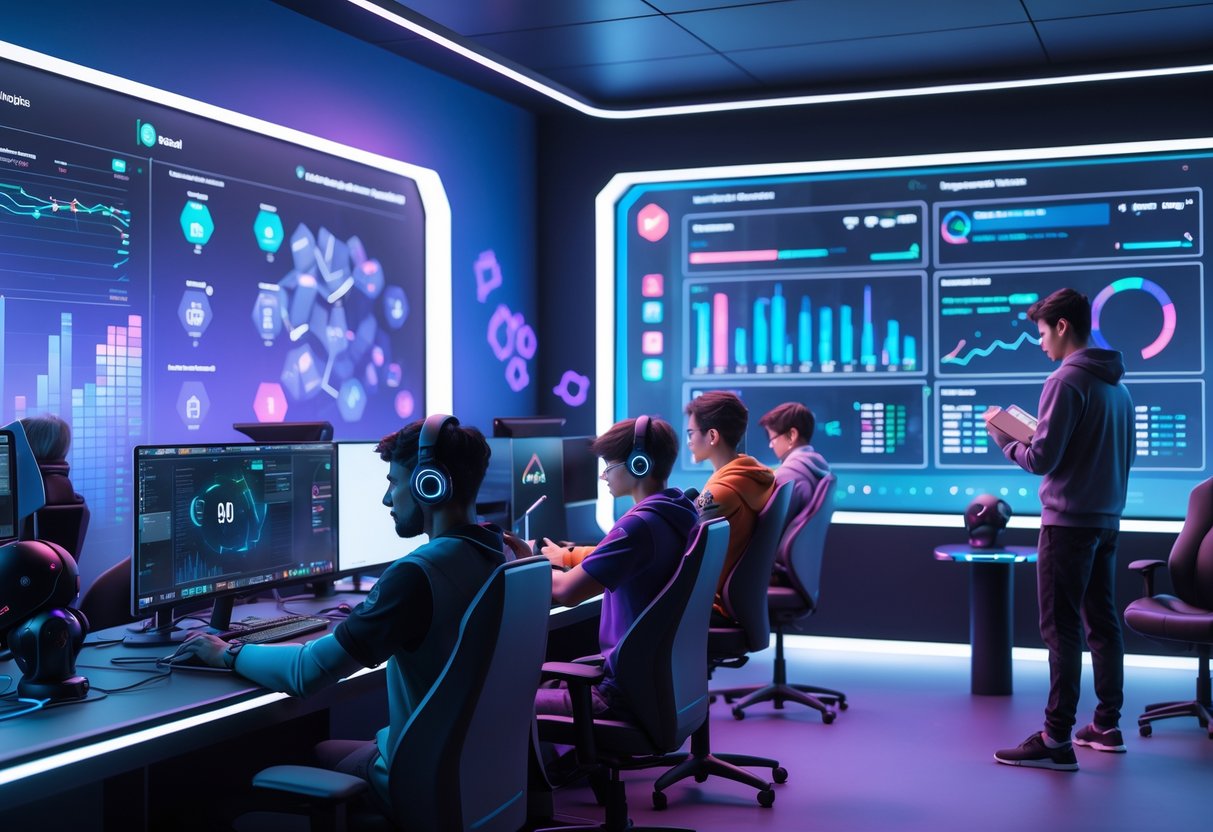
A good training programme fits each player’s strengths and weak spots, while keeping track of progress. The trick is finding a balance between technical skills, mental prep, and physical health—and tweaking things as performance metrics change.
Personalised Training Techniques
Every esports athlete brings something different to the table. Start with a skills check to see where you shine and where you struggle.
Technical Skills Development Focus on the basics first. For FPS players, aim trainers help a lot, while MOBA players should drill last-hitting and map awareness. Spend 30-40% of practice time on these core mechanics.
Mental Training Components Work on decision-making and handling pressure. Many pros pause replays and talk through what they could’ve done instead. This builds game sense faster than just grinding matches.
Physical Preparation Don’t skip exercise. Regular workouts sharpen your reactions and help you stay focused. Even 20 minutes of cardio can make a difference during those marathon sessions.
Quick win: Kick off every session with 15 minutes of aim or mechanics practice before jumping into games.
Monitoring Progress and Adjustments
Tracking what’s working (and what’s not) helps you train smarter. Look at performance metrics beyond just win rates.
Key Metrics to Track Keep an eye on your accuracy, reaction times, and how fast you make decisions. Most games spit out detailed stats after each match. Write them down every week and look for patterns.
Regular Programme Reviews Check your training every couple of weeks. If your aim’s stuck, switch up your drills or shorten your sessions. Some people do better with short bursts instead of endless grinding.
Warning: Don’t overhaul everything at once if you’re stuck—change just one thing at a time.
Adaptation Strategies If you stop improving, crank up the challenge. Try moving targets or play under a time crunch. Keeping things fresh keeps your brain in the game.
Integrating Technology in Player Evaluation
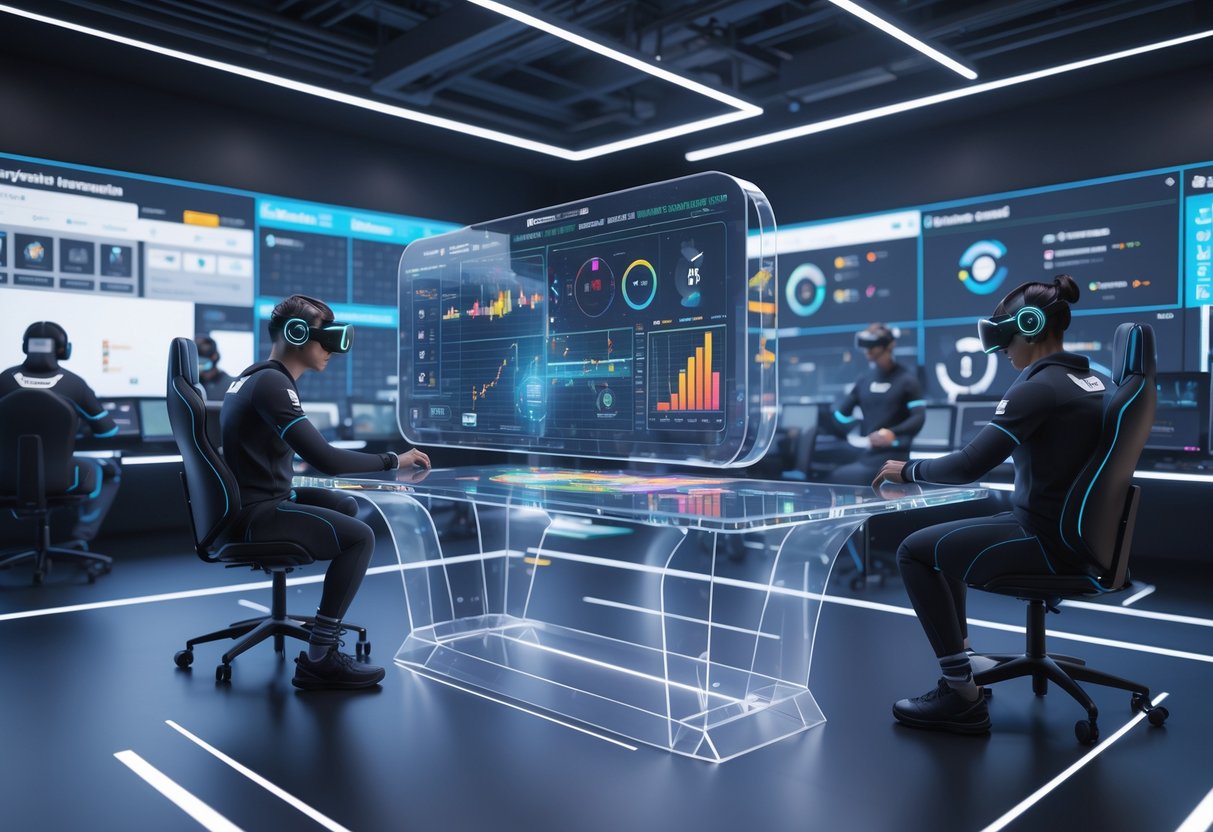
Modern esports scouting leans hard on tech to measure player potential. Two things really stand out: tracking how players physically respond in-game, and analysing their hardware setups.
Use of Biometric Data
Performance metrics from biometric sensors show how players handle stress and stay focused. Heart rate monitors reveal how nerves spike during clutch moments. Eye-tracking tech shows what players notice and how quickly they process what’s happening.
Skin sensors measure how well players control their emotions. If someone’s readings stay steady under pressure, they usually perform better in tournaments.
Sleep and recovery data can predict who’ll stay sharp over time. Top players need solid sleep habits to keep their reaction times high.
Data analytics from wearables build a full picture of each player’s physical readiness. Teams like Cloud9 already use fitness trackers to keep an eye on their roster’s health.
Body temperature and breathing during matches give away stress levels. Players who keep their vitals steady usually make smarter calls.
Quick win: Even a basic heart rate monitor (£30-50) gives you instant feedback on how you handle pressure.
Analysing Equipment and Setup
Your gear matters—a lot. Mouse sensitivity, keyboard response, and monitor refresh rates all affect how you play.
Performance metrics won’t mean much if everyone uses different setups. A 60Hz monitor slows down reaction time compared to a 240Hz one.
Good audio gear boosts team comms and helps with spatial awareness. Cheap headsets can hide weaknesses that better equipment reveals.
Internet stability also changes the numbers. Lag and packet loss can mess with your stats during online tests.
| Equipment Factor | Impact on Metrics | Cost Range |
|---|---|---|
| Monitor refresh rate | Reaction time accuracy | £200-800 |
| Mouse DPI settings | Aim precision data | £40-150 |
| Mechanical keyboards | Input delay measurements | £80-300 |
| Audio equipment | Communication analysis | £100-400 |
Warning: Testing players on different setups just isn’t fair—you end up comparing apples to oranges.
Building and Recruiting for Esports Teams
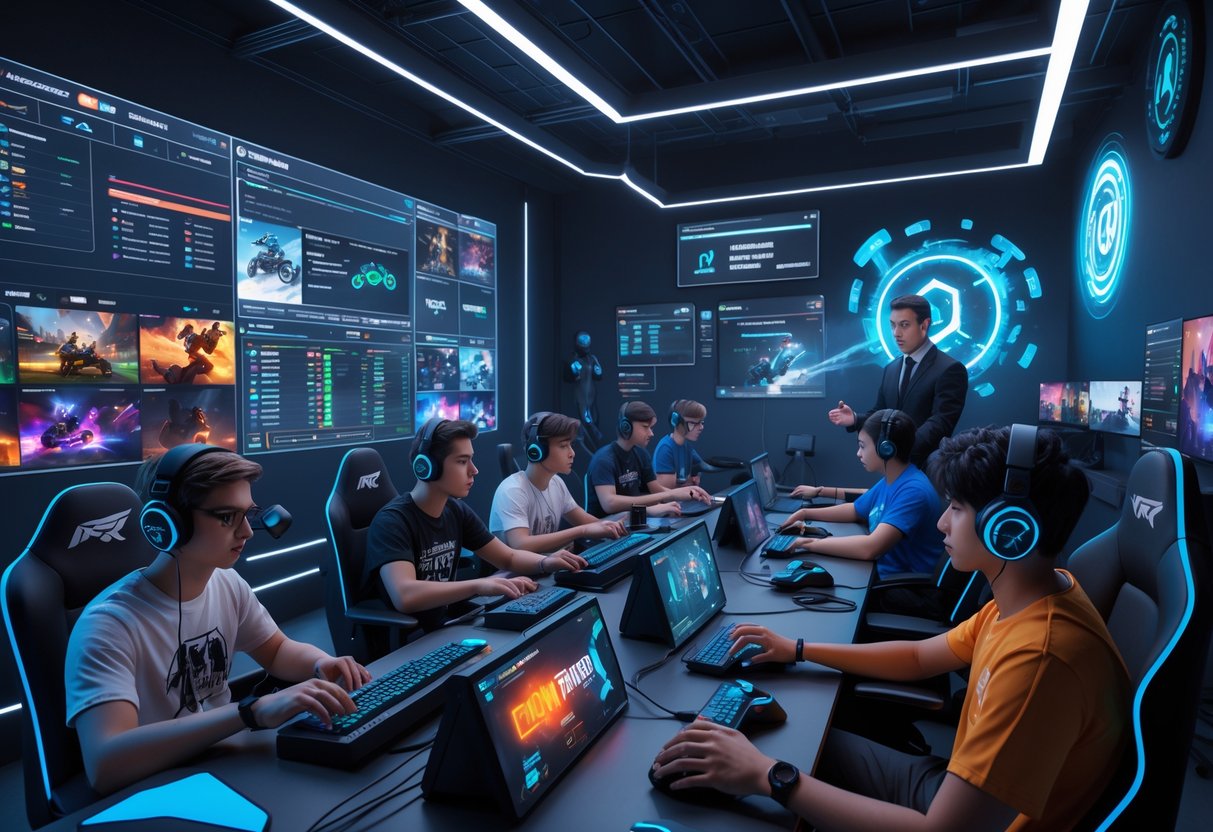
Finding great players means scouting everywhere and running thorough trials. The best teams mix data with personality checks to build rosters that actually work.
Scouting New Talent
We keep an eye on online leaderboards and ranked ladders pretty much every day. Scouts track stats in games like League, CS, and Valorant, looking for players who stay at the top for months—not just a lucky streak.
Twitch streams are a goldmine for spotting new talent. We watch for players with sharp game sense and clear comms. A lot of future pros first show up on streaming platforms.
Amateur tournaments are where we really see who’s got it. We show up at regionals and online leagues, looking for players who stay cool under pressure. Those skills transfer better to pro play than just dominating ranked.
Social media counts more than ever. Teams check a player’s brand potential alongside their skills. Players with active followings can pull in sponsors and boost team income.
Analytics tools help us spot rising stars before others do. We track things like:
- Kill/death ratios
- Objective control
- Team fight participation
- Communication skills
Trial Processes and Selections
Our trials usually run two to four weeks with the current squad. We kick things off with scrims against other pro teams to see who keeps up. If someone can’t match the pace, they’re out early.
Communication tips the scales between evenly matched players. We listen for clear callouts, steady attitudes, and how well they adjust on the fly. Toxicity? That’s an instant no, no matter how good someone is.
We also hang out off the clock—meals, games, whatever—to see how recruits gel with the team. Bad chemistry can ruin everything.
Boot camps are the big test. We bring in a handful of candidates for a week of elimination matches, strategy sessions, and intense scrims. Only a couple make the roster.
Once we pick our players, we dive right into contract talks. We cover pay, streaming, practice, and tournament commitments upfront. Setting expectations now saves headaches later.
Frequently Asked Questions
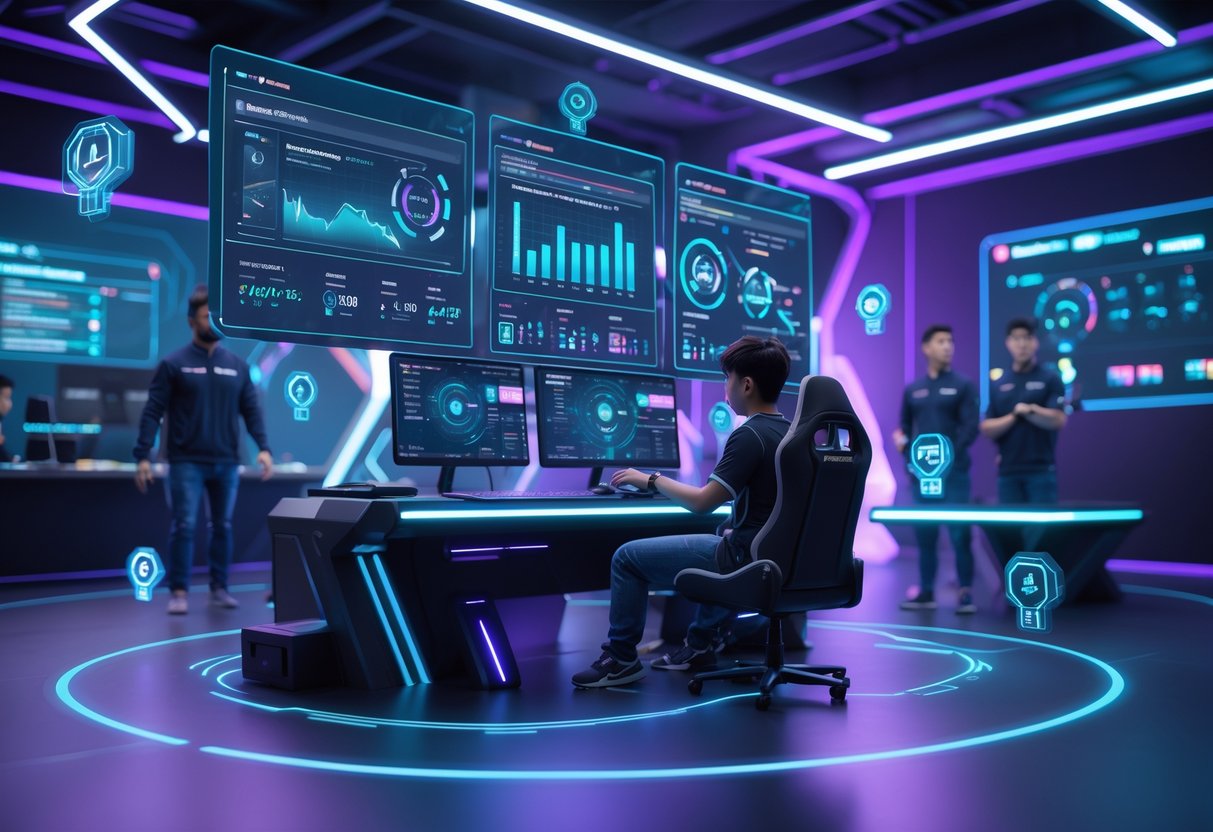
Spotting esports potential means knowing what to look for, how to measure skills, and what training backgrounds matter. Success isn’t just about raw skill—it’s about mindset, communication, and rolling with new patches or strategies.
What are the key indicators of a successful esports player?
We look for a few things when sizing up esports talent. Technical skill is the foundation, but there’s more to it.
Reaction time and precision often set the top players apart. The best consistently land their shots, pull off tricky combos, and react in a flash.
Game sense and decision-making are just as important. Players who really “get” the game make smart calls under pressure. They know when to push, when to back off, and where to stand for the biggest impact.
Communication is huge in team games. Top players call out enemy moves, help coordinate plays, and keep the team’s spirits up—especially when things go sideways.
Mental resilience lets players bounce back from mistakes. The best learn and move on instead of tilting. They stay sharp during long tournaments and keep their cool when it matters most.
Adaptability shows up when games change. New patches, new metas, new opponents—great players adjust fast.
Could you share some strategies for assessing an individual’s esports skills?
We use a bunch of methods to get a full picture. One match tells you almost nothing.
Watch gameplay over several sessions. Look for consistent performance, smart choices, and how players deal with winning and losing.
Dig into stats and metrics for each game. In shooters: accuracy, K/D, clutch wins. In MOBAs: damage, vision, objectives.
Run trial periods with the current team. This shows if new players fit in and can adapt.
Test under pressure—scrims or mini-tournaments work well. Some players shine in practice but choke when it counts.
Check how they handle feedback. Players who ask questions and actually improve are coachable.
Set up skill-based challenges tailored to the game. Aim drills, strategy puzzles, team coordination tests—mix it up.
What types of training or experience are considered valuable for someone aspiring to enter competitive esports?
We value a mix of gaming skills and real-world habits. Sports backgrounds help, but so does anything that builds discipline.
Structured practice routines show you’re serious. Players who stick to schedules, focus on specific skills, and track progress are usually more professional.
Team sports experience helps with communication and teamwork. If you’ve played football or basketball, you probably understand roles and group play better.
Academic skills in math, psych, or computer science can help with strategy and game sense.
Any competitive gaming—LANs, online leagues, school teams—gives you experience under pressure.
Content creation or streaming is a plus. Players who can explain their moves clearly often make better teammates and even future coaches.
Leadership roles show you might be captain material, whether in or out of the game.
How can one measure the impact of gaming peripherals on an esports athlete’s performance?
We test gear changes with real data. If a new mouse or keyboard helps, it’ll show up in the numbers.
Start with baseline tests before swapping gear. Record your stats—accuracy, reaction, comfort—with your current setup.
Change one thing at a time so you know what’s actually making the difference.
Track stats for each piece of equipment. For mice: look at aim and flick shots. For keyboards: input lag and key reliability.
Comfort matters more than hype. Test gear in long sessions, not just quick demos.
Pro player setups can inspire you, but don’t copy blindly. What works for one person might not fit your hands or style.
Think about cost, too. Fancy gear won’t fix bad habits or lack of practice.
What demographic factors might influence the potential for success in the esports industry?
We look at a few demographic things, but skill and grind matter most.
Age can matter, depending on the game. Fast shooters usually favour younger players, but strategy games are more open.
Location affects your chances. If you’re in a big gaming region, you’ll find more events and better internet.
Education doesn’t change gameplay, but it helps with life after esports. Transferable skills are always a good safety net.
Money helps with gear and travel, but plenty of pros started with the basics and worked up.
Language skills open more doors, especially for international teams. English is a big plus.
Culture and family support make a difference. If your environment encourages gaming, you’ll have an easier time focusing on improvement.
How are changes in the esports landscape affecting the identification of talent in the field?
We’re watching some pretty big shifts in the way teams find and judge new players. Technology, especially data analysis, has started to play a major role.
Data analytics tools now let teams track all sorts of performance stats that just weren’t available before. They dig through thousands of matches, searching for players who stand out or keep performing well.
Online platforms and streaming give talented players way more visibility than ever. Teams don’t just look at gaming skills anymore—they also pay attention to social media presence and how well someone can create content.
Regional development programmes keep popping up around the world. More countries are investing in esports infrastructure, which means players from places that used to get overlooked finally have a shot.
Educational institutions have started to set up esports programmes too. University teams often help players make the jump to a professional career.
Mobile gaming growth is shaking things up by bringing in new people and regions. Suddenly, there are fresh talent pools that teams couldn’t tap into before.
Professional support roles have gotten more specialised. Teams now look for sports psychologists, analysts, and performance coaches who really get the unique challenges of esports.

